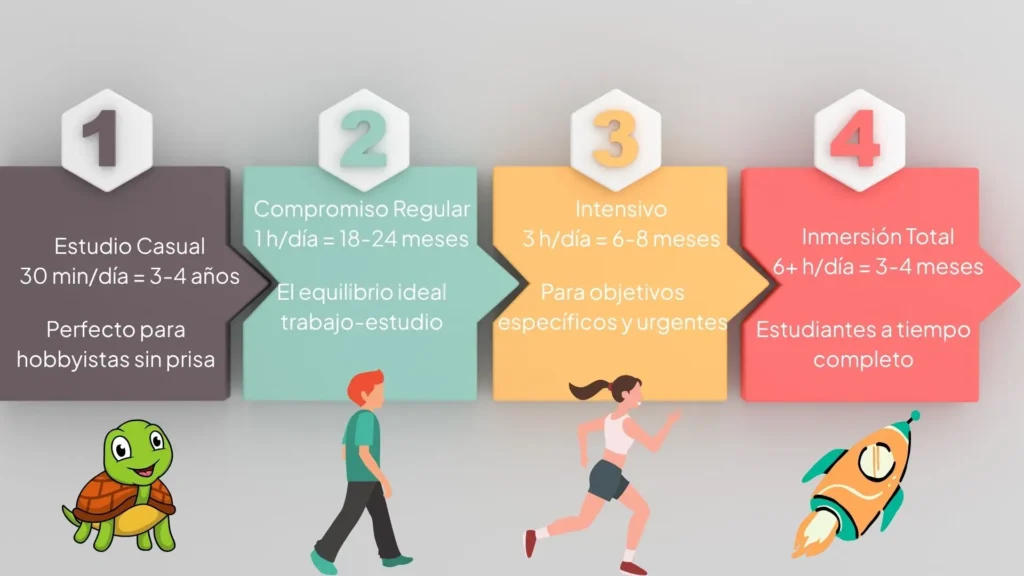Have you ever thought“I want to learn to speak Spanish” and wondered how much time you really need to communicate with confidence? In this article, I will reveal the clear answers you need and give you a realistic timeline based on real experience and scientific data.
You will discover why traditional methods underestimate your ability to learn to speak Spanish, how to accelerate your progress by up to 40% using modern techniques, and the secret that allowed me to go from total beginner to holding complex discussions in just 6 months living in Barcelona.
But most importantly, you will learn that you don’t need years to start having real experiences communicating in Spanish. There is a “tipping point” that changes everything, and I will show you exactly when you will reach it depending on your specific situation.
Table of Contents
My Story: From Anxiety to Clarity
“I want to learn to speak Spanish” was exactly what I said when I arrived in Barcelona, followed immediately by “how long will it take me?”. The answer I received was frustrating: “It depends”. But after experiencing the process firsthand and seeing hundreds of students at my academy, I now understand that this vague answer hides a much more hopeful truth.
The reality is that the time to learn to speak Spanish is not a fixed number, but a personal journey that depends on specific factors that you can control. After three months of an intensive course in Barcelona, I was able to hold full conversations. After six months, I was participating in discussions with my international classmates. And after a year, I was dreaming in Spanish.
But the most important thing I discovered is this: you don’t need years to start having real experiences speaking Spanish. With the right method, you can have meaningful conversations much sooner than you think.

The Truth About Learning Times
What Official Institutions Say
The Cervantes Institute and the Common European Framework establish these estimated times for learning to speak Spanish:
A1-A2 (Basic): 150-300 study hours
B1-B2 (Intermediate): 350-650 study hours
C1-C2 (Advanced): 700-1,200 study hours
But here’s the problem: these figures assume traditional teaching methods that do not consider your dominant learning channel or modern technology.
The Reality of Modern Learning
At E-learnSpanish we have observed something extraordinary: when our students who want to learn to speak Spanish use material designed for their dominant communication channel (visual, auditory or kinesthetic), they can reduce these times by up to 40%.
Why does this happen? Because when you learn the way your brain processes best, you don’t just memorize; you remember permanently. Each unit of our courses includes specific material for all three channels, allowing your mind to naturally choose the path it finds most efficient for learning to speak Spanish.
The 4 Factors That Really Determine Your Speed

1. Your Linguistic Starting Point
If you are a native English speaker and want to learn to speak Spanish, you have an advantage: Spanish shares approximately 30-40% of its vocabulary with English through Latin.
Advantages for English speakers:
Extensive cognate vocabulary (hospital = hospital, natural = natural)
Grammatical structure similar in many respects
Shared alphabet
2. Intensity and Consistency of Study
15 minutes per day: Basic level by 12-18 months 30 minutes per day: Fluent conversations by 8-12 months
1hour per day: Functional fluency by 6-9 months 2+ hours per day: Advanced level by 12-18 months
The crucial thing is perseverance. It is better to study 15 minutes every day than 3 hours once a week when you want to learn to speak Spanish.
3. Learning Method Used
Traditional methods: Based on memorization and grammar.
Modern methods: Digital immersion, adaptive technology, customization
At e-learnSpanish we integrate visual, auditory and kinesthetic elements so that your mind chooses the simplest path to remember, personalized learning paths, and content that adapts to your progress in real time, significantly accelerating your learning curve.
4. Immersion and Real Practice
Listening to the accents of native speakers and practicing in real situations accelerates the process exponentially. That’s why our courses include simulations of authentic conversations and access to communities of practice with students from all over the world who also want to learn to speak Spanish.
Realistic Timeline: What to Expect Month by Month

Month 1: The Fundamentals
Introduce yourself and have basic conversations
Ask for directions and make simple purchases
Understanding essential everyday phrases
Months 2-3: The Connection
Conversations on family topics (work, family, hobbies)
Describe experiences and future plans
Understanding TV programs with subtitles
Months 4-6: Functional Fluency
Discussions on topics that interest you
Understanding simple news and podcasts
Writing emails and informal texts
Months 7-12: Confidence
Natural conversations without mental translation
Humor and idiomatic expressions
Professional level for most jobs
Year 2+: Mastery
Cultural and linguistic subtleties
Literature and academic content
Indistinguishable from a native speaker in many contexts
Myths That Are Holding You Back

Myth 1: “You need Natural Talent”.
Fact: Consistency trumps talent. I have seen students with “no gift for languages” learn to speak Spanish faster than those considered “talented” but without consistency.
Myth 2: “After 25 It’s Too Late”.
Fact: Neuroplasticity works for life. Adults have advantages such as better analytical skills and clearer motivation to learn to speak Spanish.
Myth 3: “You can only learn by living in Spain”.
Reality: With modern technology and appropriate methods, you can create effective immersion from anywhere in the world.
Accelerate Your Progress: Proven Strategies

The 80/20 Rule for Spanish
80% of everyday conversations use only 20% of the total Spanish vocabulary. Focus first on these 1,000 most frequent words to learn to speak Spanish effectively.
Microhabits That Add Up Big
5 minutes to wake up: Vocabulary Flashcards
15 Minutes in Transportation: Spanish Podcasts
10 minutes before bedtime: Light reading in Spanish or games and hobbies.
Intelligent Digital Immersion
Change the language of your phone to Spanish
Watch Netflix with Spanish subtitles (no English)
Follow Instagram and TikTok accounts in Spanish
Why E-learnSpanish Accelerates Your Schedule
Our students who want to learn to speak Spanish reach conversational fluency an average of 6 months earlier than with traditional methods because we have revolutionized the way the brain retains and accesses spoken Spanish:
Multichannel Learning Material: Each unit includes visual, auditory and kinesthetic elements designed to let your mind choose the most efficient way to remember. You don’t memorize temporarily; you anchor knowledge permanently in your dominant channel.
Reinforced Memorization Techniques: Our didactic material is designed to strengthen your personal memorization technique. As you progress, your brain develops more efficient patterns for retaining vocabulary, grammar and expressions.
Real Challenges at the End of Each Unit: Each unit culminates in authentic situations where you must apply what you have learned in real-life contexts: from asking for directions in Madrid to negotiating prices in an Andalusian market. You don’t practice artificial exercises; you solve real-life situations.
Student Confrontation Space: Our platform includes areas where you can debate, converse and compete healthily with other students at your level. This social confrontation accelerates learning because it activates your natural competitive motivation and exposes you to different accents and communication styles.
Progression Based on Actual Mastery: You do not advance by elapsed time, but by demonstrating actual mastery of each skill. This eliminates the knowledge gaps that slow down progress in traditional methods.
The Honest Answer to Your Question
How much time do you need to learn to speak Spanish? The real answer is: less than you think, but more than you expect.
You can have basic conversations in 1-3 months. You can achieve functional conversational fluency in 6-12 months. You can master the spoken language in 18-24 months.
But the real secret is this: every day of progress brings you closer to life-changing conversational experiences. Don’t wait until you’re perfect to start living speaking Spanish.
Your personal timeline starts today. Are you ready to write your own success story in Spanish?
Discover the power of Spanish. It will open doors that were unimaginable until now.
Create your personalized schedule for learning to speak Spanish:
Seven-day access to one unit of the course
Immediate access to all resources with the possibility to download the document.
Don’t guess how much time you need – find out with scientific accuracy.
Register on our e-learnspanish platform and get free access to our course.
Includes full verb conjugations, real dialogues, videos explaining the lexicon and practical exercises to perfect your fluency.



